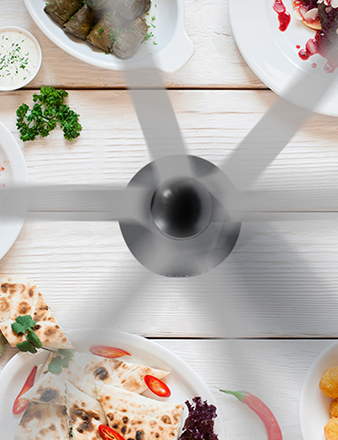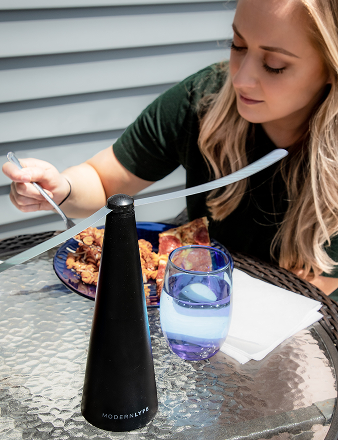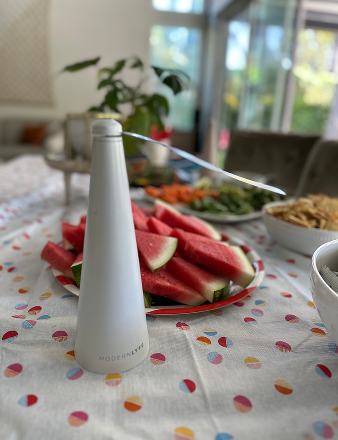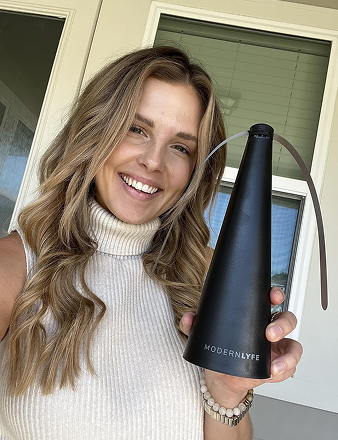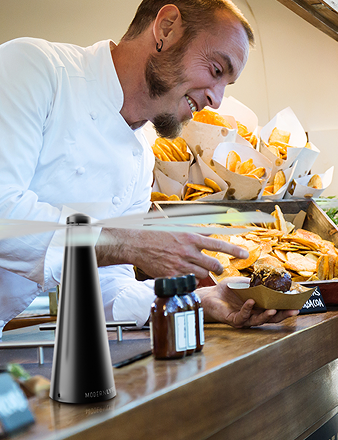Ever walk into a restaurant on a hot day and feel a gentle, invisible curtain of air at the door? That’s a commercial fly fan, and it’s doing more than just providing a cool welcome.
These devices create a powerful air barrier over doorways—think of it as a bouncer for bugs. People barely notice the concentrated airflow, but for a fly, it’s like hitting a wall. This simple, chemical-free approach is a game-changer for businesses that take sanitation and customer comfort seriously.
How Commercial Fly Fans Create an Invisible Shield
Imagine trying to swim against a powerful current. You wouldn't get far. A commercial fly fan works on the same principle. It generates a high-velocity stream of air aimed straight down across an open doorway, creating a formidable shield that flying insects can't penetrate.
The physics is simple. Flies are lightweight and aren't strong fliers. The powerful, focused air from a commercial fly fan easily overpowers them. When a fly heads for your entrance, it hits this turbulent air and is immediately pushed away. It’s silent, effective, and completely non-toxic pest control.
The Power of Targeted Airflow
This isn't your average desk fan. A standard fan just circulates air. A commercial fly fan—often called an air curtain—is engineered for precision. Its sole purpose is to create a solid "sheet" of air that covers the entire opening, leaving no gaps for pests to sneak through.
It achieves this with key design elements:
- High-Velocity Output: These fans generate air moving at a precise speed, measured in feet per minute (FPM), strong enough to stop an insect without being uncomfortable for people.
- Laminar Flow: The airflow is smooth and consistent, not choppy. This ensures the air shield is an unbroken barrier without weak spots.
- Adjustable Louvers: Most high-quality units have adjustable vents. This lets you angle the airflow slightly outward, actively pushing insects away from the building.
This focus on targeted airflow makes these fans indispensable for maintaining a clean environment. To explore the mechanics behind different fan types, our guide on fly repellent fans is a great place to start.
The real job of a commercial fly fan isn't to cool the space. It’s to establish a powerful air velocity barrier at an entrance, effectively sealing it from airborne pests, dust, and outdoor temperatures.
Now, let's look at the most common types of commercial fly fans and where they excel. This table helps you zero in on the right solution for your business.
Finding Your Commercial Fly Fan Match
This quick overview of the most common types of commercial fly fans and the environments they are built for, helping you instantly identify your best options.
| Fan Type | Best For | Key Advantage |
|---|---|---|
| Standard Air Curtains | Retail storefronts, restaurant entrances, office buildings | Creates a strong barrier against pests and outdoor air, improving both sanitation and energy efficiency. |
| Heated Air Curtains | Cold climates, walk-in coolers/freezers, main entrances | Provides the same pest barrier while also preventing heat loss and reducing energy bills in winter. |
| Industrial Air Curtains | Warehouses, loading docks, manufacturing facilities | Built for large openings with powerful motors to block dust, debris, and fumes in heavy-duty environments. |
| Low-Profile / Recessed | High-end boutiques, luxury hotels, architectural designs | Offers a sleek, hidden installation that preserves aesthetics without sacrificing performance. |
Choosing the right fan comes down to matching its power and features to your specific doorway and business needs.
A Growing Market for Cleaner Air
The rising popularity of commercial fly fans isn't surprising. It’s part of a bigger trend where businesses are getting serious about indoor air quality and hygiene, fueling massive growth in the air management industry.
In fact, the market for commercial fan and air purification equipment was valued at around USD 83.52 billion and is expected to keep climbing. This reflects a major shift toward using smart, proactive technology to keep commercial spaces pristine. You can see more data on this trend over at ResearchAndMarkets.com. It's clear that businesses are investing in solutions that work.
Why Proactive Fly Control is Non-Negotiable for Your Brand
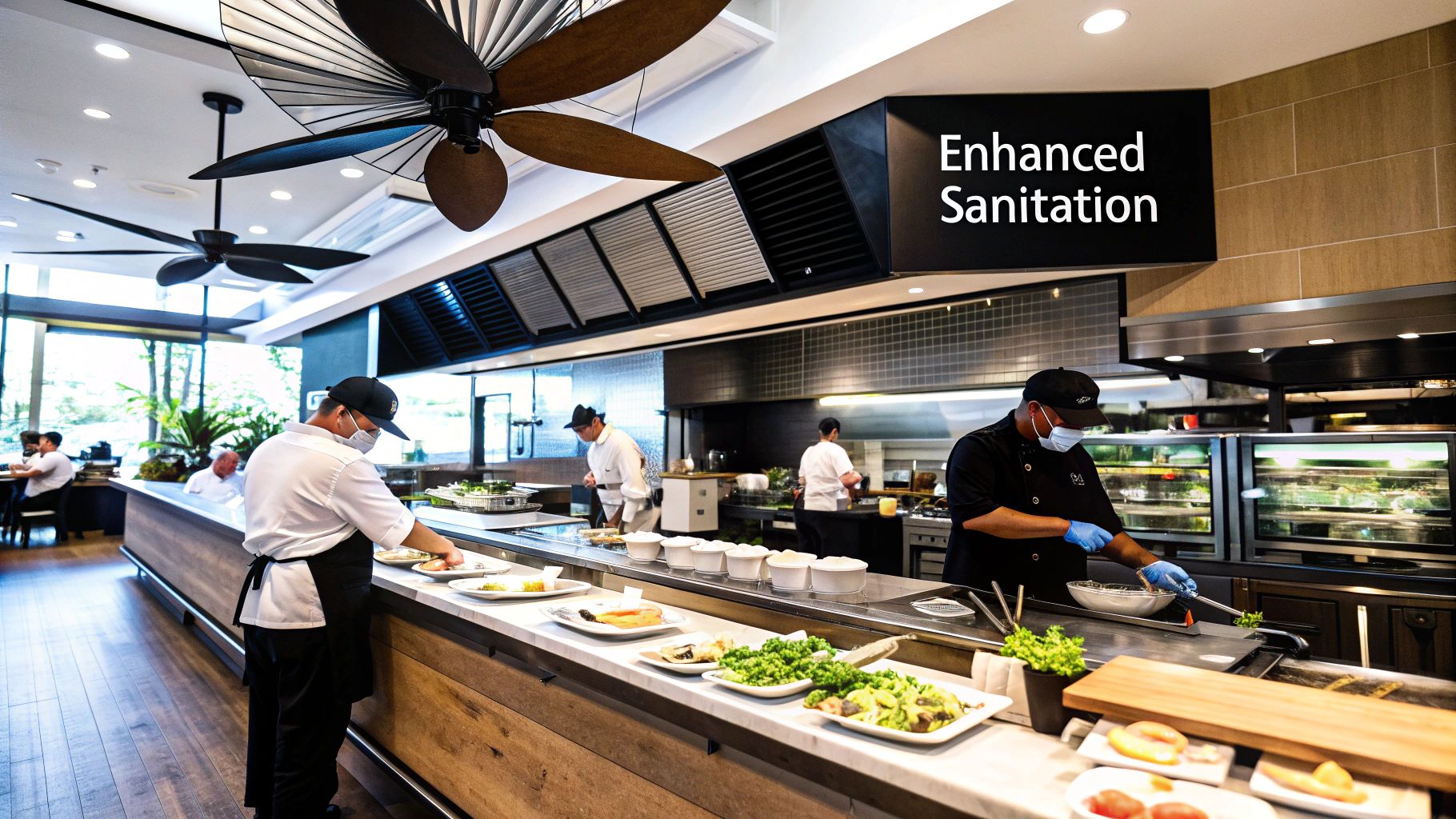
It only takes one fly landing on a customer's plate to unravel all your hard work. In a split second, the delicious meal, impeccable service, and perfect ambiance are overshadowed.
That single pest plants a seed of doubt about your entire operation's cleanliness. The link customers make between pests and poor hygiene is immediate and unforgiving. Studies show a staggering 75% of people would stop going to a restaurant if they spotted a pest.
Suddenly, that fly isn't just an annoyance—it's a direct threat to your reputation and revenue. Proactive fly control isn't another expense; it's a core investment in your brand's integrity. Using a professional solution like commercial fly fans sends a clear signal that you put sanitation and guest comfort first.
The Real Cost of a Single Fly
A fly problem is more than an image issue. These insects are notorious for carrying pathogens and transmitting diseases with every landing. For any business handling food, this poses a direct health risk.
Flies can transport over 100 different pathogens, including Salmonella, E. coli, and Cholera. They pick up germs from garbage and deposit them directly onto your food, prep surfaces, and equipment. Even one fly can trigger food contamination, make a customer sick, and lead to serious health code violations.
Getting ahead of the problem is critical. By stopping flies from entering your space in the first place, you take a decisive step to protect public health and keep your business compliant and reputable.
A proactive pest control strategy is a cornerstone of risk management for any food service business. It prevents minor issues from escalating into major health crises, negative press, and lasting damage to your brand's reputation.
Protecting Your Online Reputation
In today's connected world, a bad experience can become a public headline in minutes. A negative online review mentioning flies can scare off countless potential customers.
Put yourself in their shoes. When you're scrolling through reviews, a comment about "flies buzzing around our food" is an instant deal-breaker. It creates a lasting negative image that’s incredibly difficult to erase.
This digital word-of-mouth has a real impact on your bottom line. Research shows that businesses with even one negative review can lose up to 22% of potential customers. Investing in a reliable solution like commercial fly fans is one of your best defenses against the incidents that lead to damaging online comments.
Creating a Superior Customer Experience
Success in hospitality is all about the customer experience. You want guests to feel relaxed and comfortable. Constantly swatting away flies is the opposite of that.
By installing commercial fly fans, you create an invisible shield, allowing patrons to enjoy their meals and conversations without disruption. It’s a subtle touch that makes a huge difference in their overall experience.
This commitment to comfort and cleanliness builds real customer loyalty. When guests see you've invested in a pleasant, pest-free atmosphere, they're far more likely to return and recommend you. For more ideas, take a look at our guide on how to keep flies away from food for a deeper dive into creating a pest-free zone.
How to Choose the Right Commercial Fly Fan
Picking the right commercial fly fan boils down to a few straightforward principles. The goal is to match the fan’s power and size to the doorway you need to protect. Get this right, and you create an invisible shield that keeps pests out without bothering customers or staff.
This isn’t about guesswork. It’s a simple process of matching key specs to your physical space. Whether you’re securing a busy kitchen entrance or a welcoming patio, understanding these core factors will help you make a smart decision.
Match Fan Width to Your Doorway
The first and most important rule: the air curtain must be at least as wide as your door opening, ideally extending slightly beyond the frame on both sides. This is the only way to ensure complete coverage with no gaps.
Think of it like a curtain on a window. If it's too narrow, light pours in from the sides. A fan that’s too small for the doorway will have weak spots at the edges, rendering the air shield useless.
For example, a standard 36-inch commercial doorway needs a fan that is at least 36 inches wide. A larger 72-inch double-door entrance would need either a single 72-inch unit or two 36-inch fans mounted side-by-side to create a seamless barrier.
Understand Airflow Power and CFM
Once you have the width, the next piece is the fan’s power, measured in Cubic Feet per Minute (CFM). This number tells you how much air the fan can move. Higher CFM means a stronger airstream, which you need for taller doorways or to counter strong outdoor drafts.
Manufacturers almost always provide guidelines matching their fan's CFM rating to a maximum effective mounting height.
- Low-Profile Fans: Designed for standard doorways around 7-8 feet high, these have a lower CFM and are perfect for customer-facing areas where looks and quiet operation matter.
- High-Performance Fans: Built for taller entrances (10-14 feet) like service entries or warehouse doors, these units have a much higher CFM to ensure the airflow reaches the floor with enough force.
This visual shows how a commercial fly fan creates its invisible shield. It's a simple concept, but incredibly effective when done right.
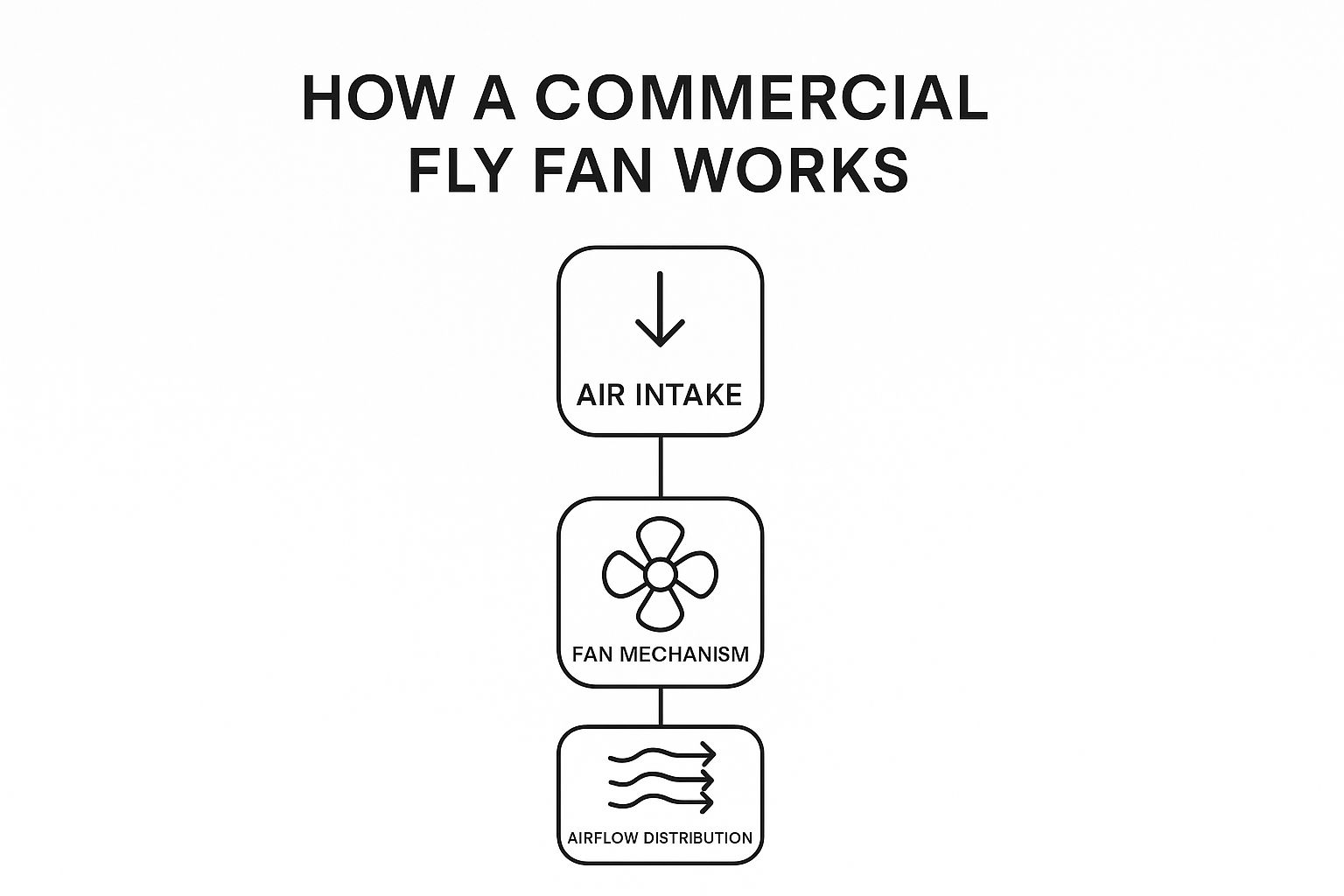
As you can see, the fan draws air from the top, propels it downward with force, and distributes it across the entire doorway to form a protective barrier.
Consider Your Environment and Aesthetics
The final piece is your specific environment. The right fly fan for a quiet, upscale restaurant is very different from one for a bustling industrial loading bay.
Keep these factors in mind:
- Noise Level: For dining rooms, patios, or hotel lobbies, look for models with a low decibel (dB) rating. Quiet operation is non-negotiable.
- Aesthetics: Some models are low-profile or recessed, blending into your decor for effective fly control without being an eyesore.
- Durability: For kitchens or industrial settings, prioritize fans with stainless steel or heavy-duty construction that can handle grease, moisture, and constant use.
This focus on matching the right fan to the right job is why the market is growing so fast. The industrial fans and blowers sector brought in over USD 10.6 billion and is expected to grow by more than 4.3% annually. Much of this growth comes from new features like variable-speed drives that help businesses fine-tune performance and cut energy costs. You can explore more insights into industrial fan technology to see where the industry is headed.
Commercial Fly Fan Feature Breakdown
Choosing a fly fan involves more than just size and power. This table breaks down the key features you'll encounter, explaining why they matter and helping you decide what's best for your specific business needs.
| Feature | Why It Matters | Best Suited For |
|---|---|---|
| Variable Speed Control | Lets you adjust airflow intensity based on wind, traffic, or time of day. This saves energy and reduces noise. | All environments, especially those with fluctuating conditions or where noise control is a priority. |
| Automatic Activation | Uses a door switch to turn the fan on only when the door opens. This is a massive energy saver and extends motor life. | High-traffic doorways in retail, restaurants, and commercial kitchens. |
| Material/Construction | Determines durability. Stainless steel resists corrosion in wet or greasy areas, while powder-coated steel is fine for dry, indoor use. | Stainless steel for kitchens and industrial settings; powder-coated steel for front-of-house and retail. |
| Heated vs. Unheated | Heated models provide a blast of warm air, great for cold climates to prevent drafts and keep staff comfortable. | Customer entrances in regions with cold winters, or temperature-sensitive warehouse environments. |
| Noise Level (dB) | A low decibel rating ensures the fan doesn't disrupt the atmosphere. Crucial for customer-facing areas. | Restaurants, hotels, cafes, and quiet retail stores. |
| Certifications (NSF, UL) | Certifications like NSF (National Sanitation Foundation) ensure a fan is approved for food service. UL listing means it meets safety standards. | NSF is a must for restaurants and food processing. UL is a standard for all commercial equipment. |
By understanding these features, you can select a unit perfectly suited to protect your space, improve comfort, and operate efficiently for years.
The most effective commercial fly fan isn't always the most powerful one—it's the one that is precisely sized and powered for the unique dimensions and conditions of your entryway.
When you carefully consider your door width, mounting height, and environment, you can confidently choose a fan that delivers maximum protection and fits perfectly into your operations.
Installation and Placement for Maximum Effect
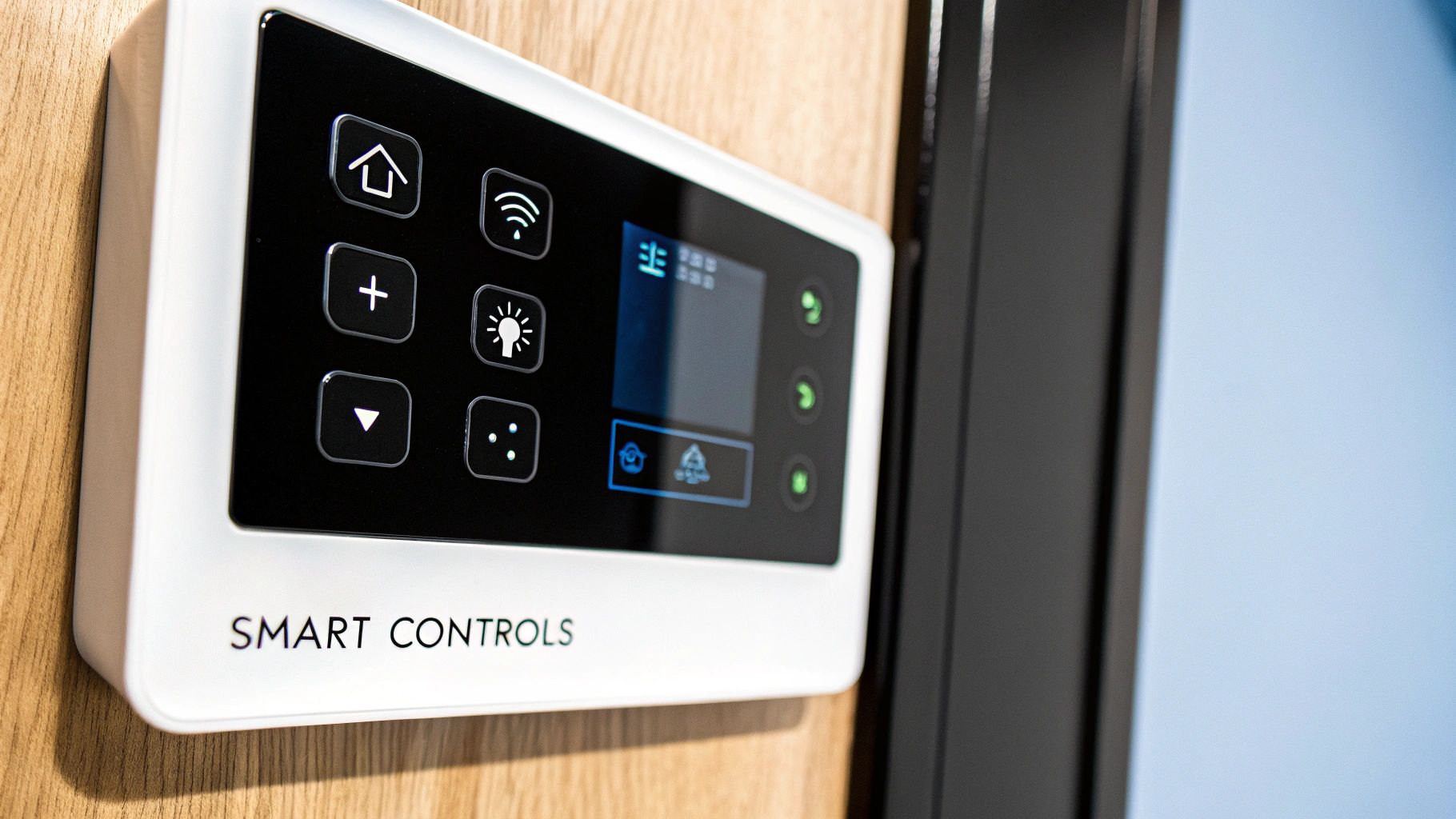
You can buy the most powerful commercial fly fan, but if it's installed incorrectly, it's just an expensive decoration. The secret isn't in the fan—it's in the placement. Getting this right turns a piece of equipment into a flawless, invisible shield against pests.
The entire concept hinges on creating a complete, unbroken seal of air across your entryway.
Think of it like patching a leak. If the patch has gaps, water will find a way through. It's the same with an air curtain. Any weak spot in the airflow is an open invitation for every fly in the neighborhood.
This is the final, critical step. It’s not just about mounting a fan; it’s about strategically creating a barrier that protects your business from the outside in.
The Core Rules of Mounting
Your number one goal is to position the fan so its airstream covers the entire door opening—edge to edge, top to bottom. This means getting the height, width, and angle just right.
Most commercial fly fans are designed to be surface-mounted right above the door header. This spot is ideal because it lets gravity assist the airflow, giving it the velocity needed to reach the floor.
For a perfect setup, stick to these non-negotiable rules:
- Mount as Close as Possible: Install the fan unit as close to the top of the doorframe as you can. The less distance the air has to travel, the stronger the barrier will be.
- Ensure Full Width Coverage: The fan itself must be at least as wide as the door opening. A 3-foot door needs a fan at least 3 feet wide. Using a smaller fan is a critical and common mistake.
- Check for Obstructions: Before you drill, look around. Make sure no signs, light fixtures, or other objects could block the fan’s air intake or the downward flow.
Proper placement isn't a suggestion—it's the key to the fan's effectiveness. The unit must be positioned to create a seamless "waterfall" of air that completely seals the entryway without any gaps.
Fine-Tuning Your Airflow
Once the fan is mounted, the last step is to aim the airflow. Most quality units have adjustable louvers or vanes that let you direct the air curtain with precision.
Here's a pro tip: the ideal angle isn't straight down. For the best results, you'll want to angle the airstream about 15 to 20 degrees outward, away from the building.
This small adjustment does two very important things:
- It creates a pushing force. Instead of just blocking insects, the angled air actively shoves them away from your entrance.
- It compensates for drafts. The outward angle helps the air curtain hold strong against incoming breezes or pressure changes from your HVAC system.
This detail can make a huge difference, especially in a windy location or with doors opening and closing all day.
Common Installation Mistakes to Avoid
Simple mistakes can completely undermine your fan’s performance. Knowing what to watch out for will save you time, money, and the headache of a pest problem you thought you’d solved.
Here are the top errors we see:
- Mounting Too High: Placing the fan several feet above the doorframe weakens the airflow before it reaches the floor, making it useless.
- Using an Undersized Fan: A fan narrower than the doorway leaves unprotected gaps on the sides that pests will slip right through.
- Ignoring the Angle: A fan blowing straight down can create turbulence that might actually pull insects inside. The slight outward angle is critical.
- Blocking the Intake: Fans need to breathe. Mounting the unit too close to the ceiling starves it of air, hurting performance and straining the motor.
Simple Maintenance to Keep Your Fan Working Hard
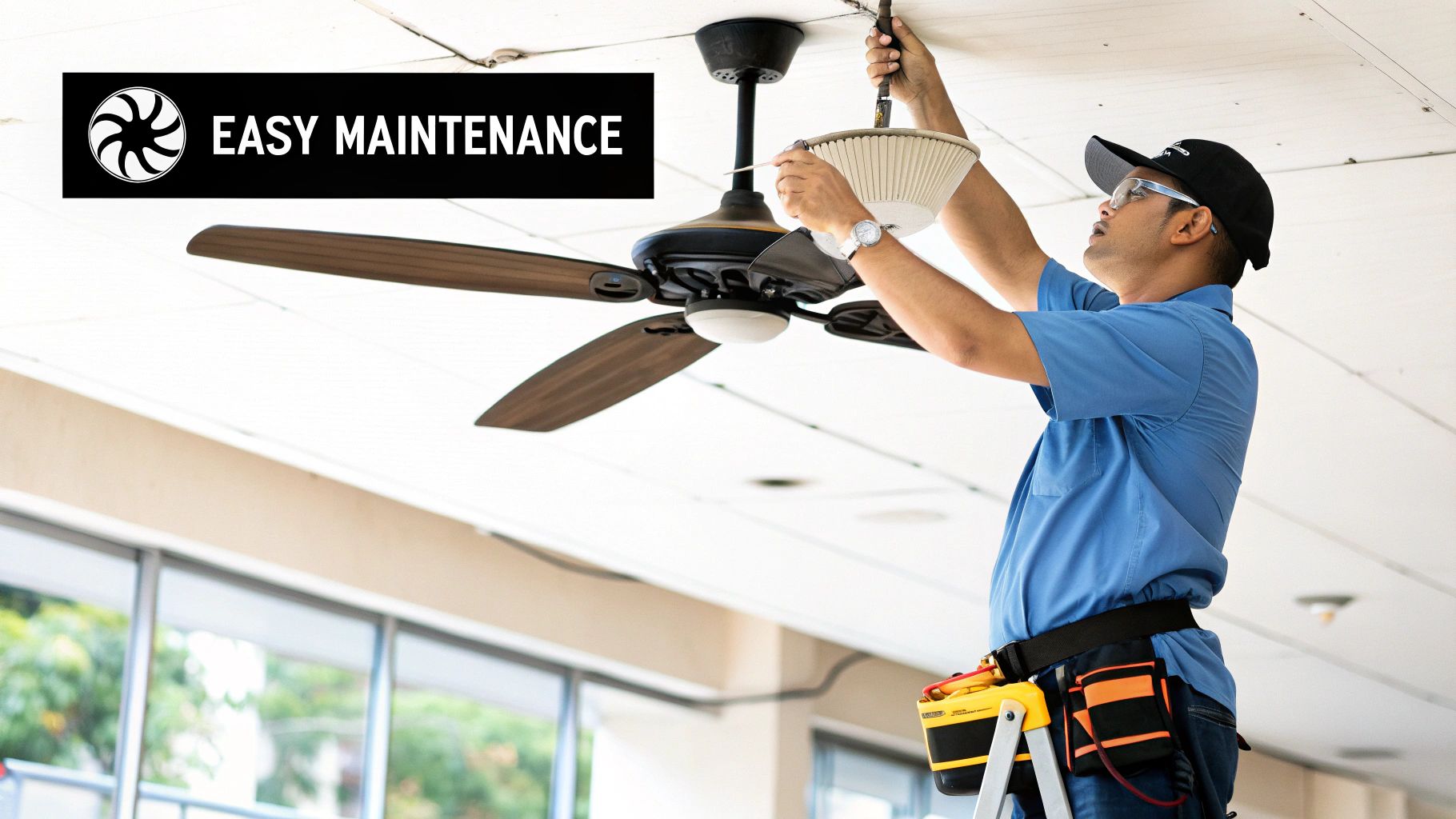
One of the best things about a commercial fly fan is that it’s a workhorse. These units are built to run for thousands of hours with very little fuss. But like any reliable equipment, a little proactive care goes a long way in keeping it at peak performance.
Think of it like the air filter in your car. When clean, air flows smoothly. Once clogged, performance nosedives. It's the same with your fly fan—simple, regular maintenance ensures it keeps creating that powerful air curtain you rely on.
This small time investment pays off. If you let it go, you'll see reduced airflow, a strained motor, and a much less effective pest barrier.
Your Quick Maintenance Checklist
You don't need to be a technician to keep your fan in top shape. All it takes is a simple, consistent routine. Schedule these checks quarterly, or more often in greasy environments like a kitchen.
Here’s a straightforward three-step process:
- Clean the Fan Blades and Housing: Power down the unit. Then, use a damp cloth to wipe down the fan blades and the inside of the housing. A buildup of dust and grease can unbalance the blades and hurt efficiency.
- Inspect the Motor and Air Intake: Check that the air intake vents are clear. A blocked intake starves the motor of air, making it work harder and causing it to burn out early. Listen for unusual sounds like grinding or rattling—a sign you might need a pro.
- Check All Connections: Give the mounting hardware a once-over. Make sure all bolts and screws are tight. Vibrations can loosen hardware, so a simple check confirms the unit is secure.
A well-maintained commercial fly fan not only lasts longer but also consumes less energy. A clean, unobstructed unit operates more efficiently, which translates directly to lower utility bills and a better return on your investment.
The Value of Upkeep in a Growing Market
Taking care of your equipment isn't just about longevity. It's about staying current with the industry's move toward efficiency and sustainability. The demand for smart air movement solutions is taking off as businesses focus on saving energy.
The global electric fan market, which includes these commercial fans, was recently valued at USD 42.7 million and is expected to grow significantly. This trend is pushed by innovations in energy-efficient motors and smart controls that lower operating costs and environmental impact. By keeping your fan in prime condition, you ensure it performs as intended. You can discover more insights about the electric fan market to see how the industry is evolving.
Got Questions About Commercial Fly Fans? We Have Answers.
It's natural for business owners to have practical questions. You're probably wondering how these fans will fit into your day-to-day operations, from the noise they make to their impact on your energy bill. Let's get straight to the point and answer the most common questions we hear.
We'll skip the technical jargon and give you the real-world answers you need.
How Loud Are These Things, Really?
This is a big one, especially for restaurants and cafes. The good news? Modern commercial fly fans are designed to be surprisingly quiet. Most manufacturers list a decibel (dB) rating, and many models operate at a volume similar to a normal conversation, easily blending into the background of a busy establishment.
For customer-facing areas, look for models designed for "quiet operation." The heavy-duty units for loading docks prioritize power over peace, so they'll be louder. The bottom line: always check the dB rating to get the right fan for the right space.
What's This Going to Cost Me in Electricity?
One of the best features of fly fans is their low energy use. Compared to your HVAC system, their power consumption is minimal. They're built to run for hours without putting a noticeable dent in your utility bill, making them an affordable part of your daily operations.
A pro tip for saving even more is to get a model with an activation sensor. These fans only turn on when the door is opened. In a high-traffic spot, this simple feature can slash energy use and ensures you’re only paying for protection when you need it.
This smart, targeted operation makes them an incredibly cost-effective way to keep your space clean and comfortable.
Can't I Just Point a Regular Fan at the Door?
I get this question all the time, but the answer is a hard no. A standard fan is not up to the task, and it all comes down to how it moves air.
A proper commercial fly fan—an air curtain—is engineered to create a powerful, uniform sheet of air that completely seals a doorway. It's an invisible barrier covering the opening from top to bottom, side to side.
- Commercial Fly Fan: Pushes out a focused, high-velocity stream of air that flies can't break through.
- Regular Fan: Creates a weak, scattered breeze with huge gaps that flies can easily navigate.
Trying to use a regular fan is like trying to stop rain with a fishing net. It’s just not the right tool for the job.
Ready to create a pest-free environment for your customers? Explore the elegant and effective solutions from MODERN LYFE and find the perfect fan to protect your space. Discover our collection.

